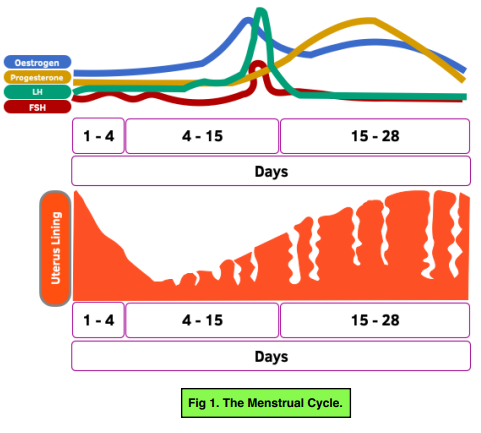Hormones in Human Reproduction - The Menstrual Cycle: Graphs (GCSE Biology)
The Menstrual Cycle: Graphs
Interpreting Data on Menstrual Cycle

As you can see in this graph, the hormones are all interacting with one another as described earlier.
The most important interactions are around Day 14. Just before day 14, oestrogen levels spike, leading to an increase in LH. Both FSH and LH levels then spike at day 14, leading to ovulation. After this, progesterone levels increase, to maintain the uterine lining.
The menstrual cycle is a recurring physiological process that occurs in females of reproductive age. It is characterized by the cyclic shedding of the uterine lining, which is regulated by hormones.
The menstrual cycle is primarily regulated by two hormones: estrogen and progesterone. These hormones are produced by the ovaries and are responsible for the growth and shedding of the uterine lining.
Estrogen is responsible for the growth and thickening of the uterine lining in the first half of the menstrual cycle. It also stimulates the development of the follicle in the ovary, which contains the egg.
Progesterone is responsible for maintaining the thickened uterine lining and preparing it for implantation of a fertilized egg in the second half of the menstrual cycle. It is also involved in the development of the mammary glands in preparation for breastfeeding.
The follicular phase is the first half of the menstrual cycle, during which the follicle in the ovary develops and matures in response to estrogen. This phase ends with ovulation.
Ovulation is the release of a mature egg from the ovary into the fallopian tube, where it can be fertilized by sperm. It occurs midway through the menstrual cycle, around day 14 in a 28-day cycle.
The luteal phase is the second half of the menstrual cycle, during which the empty follicle in the ovary develops into the corpus luteum and begins to secrete progesterone. This phase ends with the onset of menstruation.
The corpus luteum is responsible for secreting progesterone in the second half of the menstrual cycle, which maintains the thickened uterine lining and prepares it for implantation of a fertilized egg.
The menstrual cycle can be tracked using various methods, such as keeping a menstrual diary, monitoring changes in cervical mucus, or using ovulation predictor kits.
Understanding hormones in human reproduction and the menstrual cycle is important for both males and females to have a basic knowledge of how the human reproductive system works. For females, it is important for managing menstrual health, understanding fertility, and preventing unwanted pregnancies. For males, it is important for understanding their role in reproduction and for supporting the reproductive health of their partners.






Still got a question? Leave a comment
Leave a comment